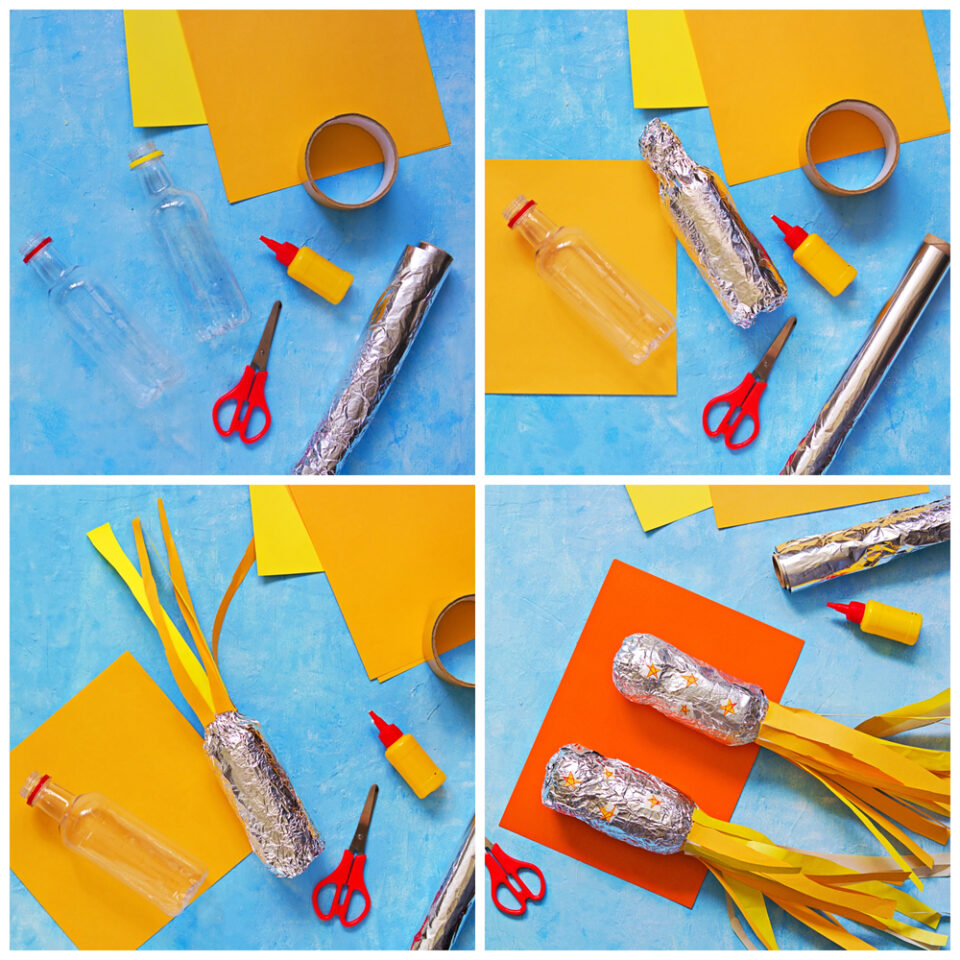
This Bottle Rocket Will Make Your Kids’ Imaginations Blast Off
The American philosopher John Dewey said, “Every great advance in science has been issued from a new audacity of imagination.”
And he was right. From electricity to the internet, the most significant scientific discoveries started as a think-outside-of-the-box idea.
Imagination even helped us reach new heights within our galaxy. Astronaut Neil Armstrong was born in the midst of the Great Depression, but he dreamed of a brighter future—and that included traveling to space. When Armstrong became the first person to walk on the moon in 1969, he inspired a nine-year-old girl named Peggy Whitson to reach for the stars, too. Whitson went on to become an astronaut and set the record for the most time spent living and working in space by a NASA astronaut at a total of 655 days. Without big dreams, these amazing feats would never have come to fruition.
It’s important to inspire and stoke the imaginations of our next generation of great explorers. You can introduce your children to the wonders of outer space with a craft that gets them thinking about blasting off into orbit. Let’s build a rocket from a bottle!
Getting to Know Rockets
Hearing the word “rocket” might conjure images of a tall, slender tube with a pointed nose that launches astronauts into space. While that description fits a particular type of rocket, there are many other kinds too.
A rocket is any device that produces force to push an object forward. Some fireworks, for example, are technically a type of rocket. Military planes use rocket motors on their ejector seats, and there are even rocket-powered bicycles that can go faster than 200 miles (321 kilometers) per hour.
Rockets are often thought of as a modern invention, especially since they’re closely connected with space travel, but they have a long history. One of the first objects to successfully use rocket power was a wooden bird from around 400 BCE. According to Roman writer Aulus Gellius, the Greek philosopher Archytas used a steam-powered rocket to move the bird forward on a suspended wire.
The first reported use of “true rockets” was in China in 1232 CE. Around this time, the Chinese began experimenting with gunpowder to create weapons for war with the Mongol Empire. One weapon was the “fire lance” or “fire arrow,” a bamboo case filled with gunpowder and attached to a long stick. Soldiers could launch a stick toward the enemy by lighting the gunpowder.
Though the technology spread to Europe, by the sixteenth century, firework displays were more common than rockets. It wasn’t until 1898 CE that modern rocketry began in earnest, thanks to a Russian teacher named Konstantin Tsiolkovsky. He had a remarkable idea: humankind could use rockets to go to space. Tsiolkovsky’s research and science experiments marked the start of modern astronautics, and his work helped pave the way for the fantastic discoveries of modern space explorers.
But how exactly do space rockets work? A rocket has four main parts:
- Nose cone: The nose cone is the often rounded, bullet-shaped section at the top of a rocket. This shape helps minimize air resistance while giving the rocket greater stability and control over its direction. The nose cone carries the rocket’s “payload,” which can be satellites, cargo, explosives, or even people. When astronauts enter space, their cabin is typically in the nose cone.
- Fins: A rocket’s fins also help maintain control and stability. They keep the rocket pointed in the right direction and prevent it from teetering or wobbling. Engineers typically put fins on the rear of a rocket.
- Body: The long, cylindrical tube that makes up most of a rocket is called its “body.” This piece stores the rocket’s engine and propellant, the chemical mixture the engine burn to propel the spacecraft forward.
- Engine: The engine burns propellant to keep the rocket moving forward, just like a car’s engine burns gas. Rocket fuel varies depending on the type of engine. In a spaceship, the propellant consists of both fuel and oxidizer, which keeps the fuel burning even outside Earth’s atmosphere (where there’s no oxygen).
The work of Sir Isaac Newton, one of the greatest mathematicians and physicists in history, is important for understanding how rockets fly in space. Newton’s third law of motion states that for every action, there must be an equal and opposite reaction. This means that when force is exerted on an object, it exerts an equal force in return.
Imagine going roller-skating with a friend. You and your friend stand opposite each other, and you place your hands on their shoulders and push. Your friend will move backward because of the force you applied to them, but you’ll move backward too, even though they didn’t push you. That’s Newton’s third law at work. When a rocket launches into space, the engine burns propellant and forces the exhaust downward, creating a thrusting force. This puts equal force on the body and nose cone, propelling them up and into the atmosphere. Once the rocket reaches outer space, the thrust from the engine’s exhaust continues to push it forward until the spacecraft (and its crew) arrive at their destination.

How to Make a Rocket from a Bottle
This plastic bottle rocket craft is a great way to introduce the different parts of a rocket to your children. While crafting, you can highlight the nose, fins, and body and share amazing facts about outer space. Best of all, the finished product makes a great DIY toy for space-themed play.
You don’t need much for this: just a plastic soda bottle, some foil, and a bit of imagination. Here’s how to make a rocket from a bottle.
Materials
- Empty plastic bottle (like a water or soda bottle)
- Construction paper (yellow, orange, and/or red)
- Child-safe scissors
- Aluminum foil
- Nontoxic glue
- Stickers
Directions
- Wrap a plastic bottle with aluminum foil.
- Cut the construction paper into long strips (younger children may need an adult’s help). Glue these around the bottle’s base to represent the flames and hot exhaust coming from the engine.
- Cut two small right triangles (about 1 inch or 2½ centimeters tall) from the construction paper and glue them to the sides of your rocket at its base. These are the rocket’s fins.
Finally, decorate the water bottle rocket with stickers. Add stars, aliens, or any other fun shapes. Once finished, the little rocket is ready for launch!

Enjoy Endless Galactic Fun
This bottle rocket craft is a wonderful activity for a future space explorer’s birthday party or creative addition to a space-themed playroom. After you’ve wrapped up your rockets, give another of our awesome space crafts a try and help your kids’ imaginations blast off into the stratosphere.
